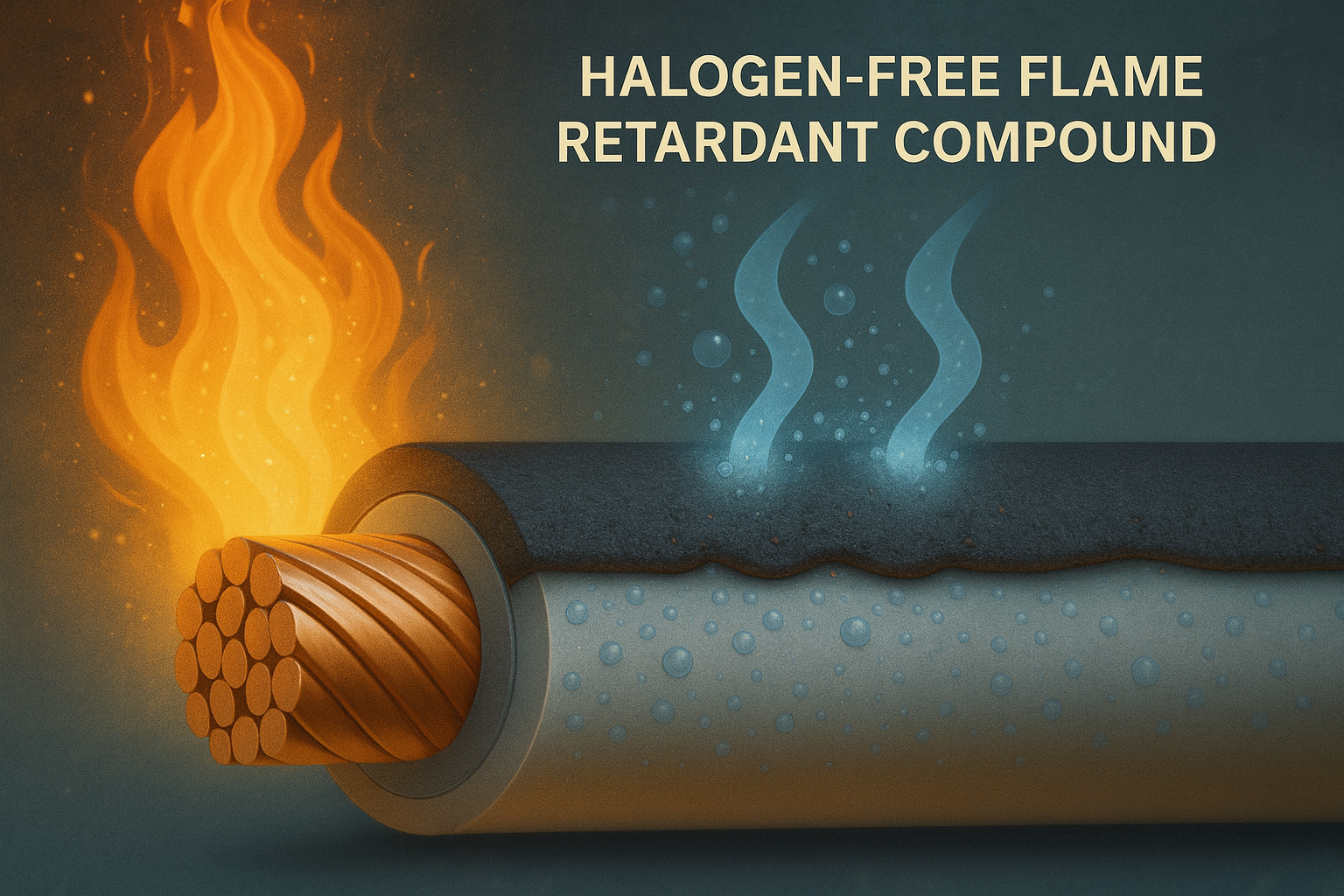LYS Polychem Blog

How Do HFFR Compounds Work?
The Need to Increase Safety Without Compromising Performance
Success in the polymer and cable industry requires managing key balancing factors such as performance, processability, and cost. However, recent developments like CPR, the Construction Products Regulation, and increasing global safety demands have added new, mandatory criteria to this equation. Now, manufacturers' sole goal is not just to delay flame spread; they must also meet low smoke density and zero halogen criteria without compromise.
This is where HFFR (Halogen-Free Flame Retardant) compounds establish a clear superiority over older halogenated systems (e.g., FR-PVC). It would be wrong to view HFFR granules merely as a plastic material; they are smart solutions that manage the chemistry of fire through thermal decomposition.
In this article, we will focus on the endothermic protection mechanism behind HFFR compounds and examine the critical role of this material in compliance with CPR and LSZH standards in a clear and results-oriented language for industry professionals.
Fire Protection of Cables: Three-Stage Protection Mechanism
The fundamental difference between HFFR compounds and halogenated systems is that they are based on reducing temperature and creating a physical shield during a fire. This defense mechanism relies on the high content of metal hydrates (mainly Aluminum Hydroxide - ATH and Magnesium Hydroxide - MDH) and occurs in three main stages:
1. Heat-Absorbing “Smart” Cooling
When HFFR comes into contact with fire and reaches its critical decomposition temperature, the metal hydrates release water from their structures. This process absorbs a large amount of heat energy from the environment. This endothermic effect rapidly lowers the temperature of the polymer surface, helping to keep it below the cable's ignition threshold and effectively slowing the spread of flames along the cable.
2. Oxygen-Depleting Water Vapor Curtain
The water vapor released during heat absorption instantly dilutes the combustible gases and oxygen concentration in the flame zone. This smothering effect significantly slows down the combustion reaction. Most importantly, HFFR systems do not produce corrosive and toxic hydrogen halide gases. This is a critical difference in terms of equipment corrosion protection and life safety.
3. Protective Carbon Shield Formed on the Surface
In char-forming engineering plastics, metal oxides and polymer residues form a dense, insulating carbonized layer (char) on the surface at high temperatures. This layer acts as a physical shield that breaks the contact between the flammable polymer and the flame. This barrier not only stops the spread of flames, but also minimizes smoke formation.
Why HFFR? Regulations and Market Competition
To be competitive in the market and participate in projects, it is not only the flame retardant performance of an HFFR compound that is decisive, but also its compliance with CPR Classes (e.g., B2ca, Cca, etc.). HFFR is far superior to traditional materials in meeting low smoke (s1, s2, etc.) and zero corrosivity (a1, a2) criteria.
Focus for the Manufacturer: Choosing the right HFFR compound is a critical factor in enabling the cable to achieve demanding CPR classes such as Cca−s1,d1,a1. The compound's thermal stability, mechanical strength, and processability must be maintained despite the high filler content. Specific performance requirements can be met with compounds developed specifically for different applications (such as High ESCR or TI7).
The Secrets of High Performance Production
Using a high proportion of inorganic filler can create difficulties such as increased viscosity and decreased mechanical properties during extrusion. Modern HFFR compound manufacturers have developed active solutions to overcome these challenges:
Advanced Binder Chemistry: Optimizes the compatibility between the polymer and inorganic filler, preserving critical mechanical properties such as flexibility and elongation despite high filler content.
Special Additives: Increases the fluidity of the compound and ensures stability even at high speeds in extrusion lines. This plays a key role in terms of cost and production efficiency.
Synergistic Approach: By using synergists such as zinc borates or phosphorus-based compounds, it increases the flame retardant efficiency of metal hydrates, thereby optimizing the overall filler ratio and maintaining processability and cost balance.
In summary, HFFR compound represents high engineering performance that meets not only safety requirements but also demanding technical specifications and international standards.
Frequently Asked Technical Questions (FAQ)
1. How Does Filler Content Affect Mechanical Properties?
As filler content increases, flame retardant performance improves; however, elongation at break and tensile strength decrease due to reduced continuity within the polymer matrix. High-quality HFFR granule compounds minimize this decrease by using binding agents and maintain the desired mechanical values despite high filler content.
2. Which HFFR Base is More Suitable for Applications Requiring High Thermal Stability?
ATH has a relatively low decomposition temperature. In applications requiring high service temperatures (e.g., 90°C and above) or harsh thermal conditions, MDH (Magnesium Hydroxide)-based compounds with higher decomposition temperatures provide better thermal stability than ATH-based solutions.
3. What is the Fundamental Difference Between HFFR and LSZH?
HFFR (Halogen-Free Flame Retardant) defines the chemical structure of the material (i.e., the granular compound) and its flame-retardant properties. LSZH (Low Smoke Zero Halogen) is a general term used in the cable industry to describe the performance of the finished product. HFFR is a fundamental component of an LSZH-labeled cable.
4. Why is the Processability of HFFR Critical in Multi-Layer Cables?
In multi-layer (Co-Ex) cable production, the viscosity consistency of the compound and its adhesion properties to different layers are of vital importance. The precise viscosity control of HFFR prevents interlayer separation during high-speed extrusion and ensures consistent product quality.